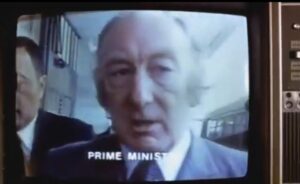1989: Idiot Played Rachmaninov
September 21, 2024
By AHNZ

The New Zealand dystopian novel genre was already thriving in the 1980s when Michael Brown (1948-) capped it off with The Idiot Played Rachmaninov. We already had C.K. Stead’s Smith’s Dream (1971) and Craig Harrison’s The Quiet Earth (1981) and Maurice Gee’s Under the Mountain (1979) which all made it to screen as well. Brown also had the example of the New Zealand Police’s Red Squad to study after its role in the mini civil war between pro and anti-Springbok rugby tour New Zealanders. One of his themes in Rachmaninov is official professional violence vs. civilian paramilitary violence.
New Zealand’s Boomer Awakening (Second Turning) came to an end with the 1970s decade. Our Hippy-protest anti-establishment ‘Nambassa’ generation had had a merry time discrediting and deligitimising the old post-war order but this had run its course. Now set in a time of anxiety and the fear of blow-back as the pendulum was due to swing against them and toward the more conservative culture of the 80s and 90s. Indeed, the revolutionary political and economic changes were on the way thanks to David Lange (Labour 4.0) and National 4.0 (Jim Bolger.)
Quiet Earth imagined DNA-altering experiments that wiped out New Zealanders en mass, destroying our entire culture. Those left behind affirm Aristotle’s “man is a social animal” edict by going doolally. This, by the way, is an exaggerated version of what many New Zealanders really did fear during the COVID-19 Panic and what some consider to have come to pass! Ref. Reality Check Radio
Under the Mountain was more surreal science fiction about our nation’s doom. Alien slugs “Wilberforces” with no feelings or conscience seek to conquer and multiply to the destruction of New Zealand and the entire galaxy itself. In other words, says Gee, they’re just like some politicians on Earth! They can no more be reasoned with or appealed to than a school of sharks. The Generation X kids have figure out to distrust them and align instead with the elder “Mr Jones” before the North Island volcanic cones blow us all away. It’s basically the moral dilemma of Charlie Sheen’s character in Wall Street (1987) picking between contemporary ‘shark’ Gordon Gekko and elder Lefty dad Martin Sheen.
“New Zealanders may well wake up one day to find a military dictator riding them and wonder how he got there…. You can’t inherit freedom; yet most of our institutions are inherited and there is no common understanding that they were born of struggle.”- Bill Pearson
“Now you listen to me, and listen carefully. Frazer Creek is about to become a goldfish bowl. There’ll be more reporters there inside twenty-four hours than you can shake a writ at. Australia is standing over the CER agreement with a slasher. We’re holding the voters, but only just.’ He nodded at the photograph. ‘This kind of media manipulation is so damaging that if we have another loss, we could go under. If I invoke open censorship, we could still go under because this imagery is already out there doing its work. But most importantly, if Renwick allows his men to give vent to their wounded feelings we will certainly go under. He must, I repeat, must, deal with the terrorists, but in a manner that will stand public scrutiny. Do I make myself clear?” – p95, Brown (1989)
 Well, same thing going on in Rachmaninov more or less. Closer to Smith’s Dream in being realistic, New Zealand has been corrupted by some of Maurice Gee’s slug people who are running the government. It’s not extinction we face so much as fascist dictators treating the people like their livestock. The pretense that government is supposed to serve us has been dropped and clearly it is we who are on a slave plantation run by a power elite. In Stead’s book it’s Prime Minister Volkner, in Brown’s he goes unnamed but we learn much more about him including his Ayn Rand bookshelf (must be evil.)
Well, same thing going on in Rachmaninov more or less. Closer to Smith’s Dream in being realistic, New Zealand has been corrupted by some of Maurice Gee’s slug people who are running the government. It’s not extinction we face so much as fascist dictators treating the people like their livestock. The pretense that government is supposed to serve us has been dropped and clearly it is we who are on a slave plantation run by a power elite. In Stead’s book it’s Prime Minister Volkner, in Brown’s he goes unnamed but we learn much more about him including his Ayn Rand bookshelf (must be evil.)
Brown weaves in some genius ideas in his book such as the economic premise that South Westland has become an El Dorado of export-quality thorium for which the world energy markets hunger. In response, the locals have spontaneously revived the industrial organisation that once served their ancestors in the Gold Rush era. Or, the days of bush moonshine distilling. Against this cottage industry comes Big Government in control of outsiders who insist (in the name of the country) the land and its resources belong to them. Brown’s idea reminds me of Isaac Asimov’s Foundation novels in that West Coasters have always had a latent ability for technological innovation and production. It’s just that the gold stopped. But when thorium came on the market the Coasters simply played on. This is explained very well in the novel.
A rush for minerals, these days, certainly would be controlled by elites who would say the land belonged to “The Department of Conservation” or “The Crown.” Whereas, back in the 1860s, anybody (from anywhere) could stake a claim in the un-owned wilderness and start generating wealth. When the book was written in 1989 it still seemed plausible that South Westland belonged to South Westlanders and not the Wellington power elite. In the 2020s I think we’ve been propagandised so well that everyone would bow to The Government automatically having the rights to any undeveloped wilderness even if it had nothing to do with discovering or developing it. And, even if The Government doesn’t give a damn about having a mutual relationship with a place like South Westland until there’s something worth taking from it; Like some long-lost relative who suddenly wants to be in your life after you win the lottery.
 Colin Renwick is the attack dog sent by The State to protect the government thorium dredge and subdue the cottage thorium industry. The author does a really good job detailing how this little SIS splinter group works as well as the news media (having been one of them himself.) There are some excellent action scenes where the locals prosecute asymmetrical warfare on the black beret and jackbooted ones. Many of these are spoiled in the preface of the book which ought to have been an epilogue. There are refreshing insights showing that soldier-police attract bullies to their ranks even if they are pacified with bus loads of Christchurch prostitutes. Despite his technical expertise, training, attack helicopters, troops, backing, torturers, etc. Renwick is driven to the point of mental breakdown in trying to break the Westlanders.
Colin Renwick is the attack dog sent by The State to protect the government thorium dredge and subdue the cottage thorium industry. The author does a really good job detailing how this little SIS splinter group works as well as the news media (having been one of them himself.) There are some excellent action scenes where the locals prosecute asymmetrical warfare on the black beret and jackbooted ones. Many of these are spoiled in the preface of the book which ought to have been an epilogue. There are refreshing insights showing that soldier-police attract bullies to their ranks even if they are pacified with bus loads of Christchurch prostitutes. Despite his technical expertise, training, attack helicopters, troops, backing, torturers, etc. Renwick is driven to the point of mental breakdown in trying to break the Westlanders.
Again, for the The Little Red Hen local resistance group to Renwick’s occupation, the author weaves in clever threads from real life. Of course they have expert helicopter skills of their own honed from the era of live deer capture and hunting. In 1989 we did have flying aces that could provide air support like that to fight back against a corrupt state. They also had precision tree felling skills. And, enhanced abilities at using trank dart guns. Brown also calls up several times Westland’s legend of Stanley Graham who made fools of everyone and everything The State could throw at him for days until, finally, he was shot dead. Ref. 1941: The Graham Manhunt, AHNZ
The idiot playing Rachmaninov on the piano is a girl, Rosa, who becomes the symbol of Westland under the boot. Renwick knows he will lose the propaganda war with the locals, the nation, and the watching Australian media, if he cannot keep his men from their inclination to commit atrocities. The Little Red Hen know it too and that this is the true battlefront rather than anything they can hope to do with espionage or counter-insurgency. Renwick is a bit like the bad guy in Amadeus (1984) who cannot accept he is being outmatched by keyboard savant (Rosa/Mozart) who are otherwise silly and functionally incompetent. Is Rosa really intellectually impaired?
Like Renwick I was a bit let down by Sleeping Dogs and Rachmaninov that they offered no formal true blue Kiwi leader and their squad. In my ideal there would be some tightly knit co-inspired group who were highly loyal to one another and to their cause. I’m thinking of Hogans Heroes (1965,) The A-Team (1983,) or Star Trek (1966/1987.) As far as I know we’ve never had a New Zealand model for that beyond kids cartoons. Maybe Stead and Brown know something I don’t. Their people are messy, in-fighting, manipulative, conflicted, traitorous, disloyal, unfriendly, uninspirational. As in real life. Whereas, I’m always looking for heroes.
 Like Comment Share
Like Comment Share





